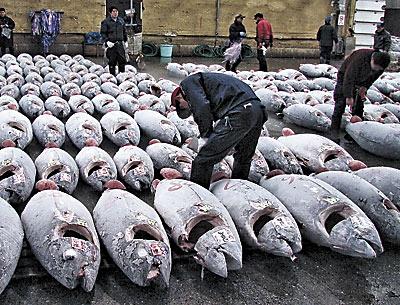The Tuna Rose

As it has for the past 30-odd years, my White Dawn rose has blossomed the third week of June. I call it the Tuna Rose as the bloom coincides with the arrival of giant bluefin tuna into our local waters. Or so it was in the ’80s when I planted this young rose.
Back then at this time each year, the activity level around the docks in Montauk would step up like the degrees on a summer thermometer. The excitement generated by these magnificent fish was evident everywhere. For decades after the first giant was caught by a Montauk angler in the late ’40s, these monster tuna, sometimes weighing over 1,000 pounds, were prized only as a sportfish. The sushi craze had not yet exploded, and the cost of ice to ship a giant to the New York fish market exceeded what might be gained from the sale.
But by the ’80s that had all changed. Tuna, especially giant bluefins, meant big money, with a single fish selling for more than $10,000. As a result it was not unusual to find 40 or more boats on the fishing grounds before the June sunrise so as not to miss the dawn bite.
Montauk fishermen were by no means alone in their pursuit. From all over the world bluefins were packed in ice and next-day air-freighted to the Tsukiji fish market in Tokyo. Japanese buyers paid to have locals trained to inspect tuna at the dock for fat content, which translated to market value.
As the rage accelerated, what little remained of sportfishing sensibilities vanished. I doubt there are many left around the docks who can recall what the International Game Fish Association (IGFA, the governing body of sportfishing) regulations dictate. Fish were no longer gaffed, but rather harpooned when they were brought close to the boat; line strengths jumped to 200-to-300-pound test, more than any category recognized by IGFA, and “anglers” caught fish without ever removing the rod from the rod-holder.
Today I dropped by the Montauk Marine Basin to see what was happening. Not much. No giants.
Bluefin tuna stocks worldwide have fallen dramatically, with the western Atlantic stock down by 82 percent compared with 1970, a time when bluefins were already in decline.
Recent decades have seen efforts to manage tuna worldwide. This is an exceedingly complicated and controversial subject. Catch limits have been exceeded for decades, enforcement is unimaginably difficult, and progress almost nil. Trapped and ranch-raised tuna is a booming business, while wild stocks of young fish are depleted to supply the ranches.
In 2013 a Japanese sushi supplier paid $1.76 million for the honor of buying the first tuna of the year.
My Tuna Rose is still going strong and costs less than two pieces of maguro in annual maintenance, but the words of John Sawhill, a past president of the Nature Conservancy, float on the scent of the rose: “In the end, our society will be defined not by what it creates, but by what it refuses to destroy.”
Bill Akin is a Montauk resident. As a boy he fished out of the Montauk Yacht Club in the 1950s and ’60s, catching giant bluefin tuna, swordfish, and both white and blue marlin before he turned 16. He is a past president of the Concerned Citizens of Montauk, past board member of Wild Oceans, and the author of “Montauk Is,” a collection of haiku and short poetry.
